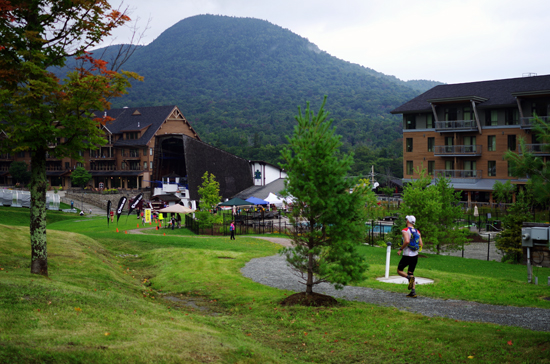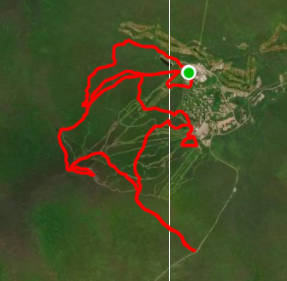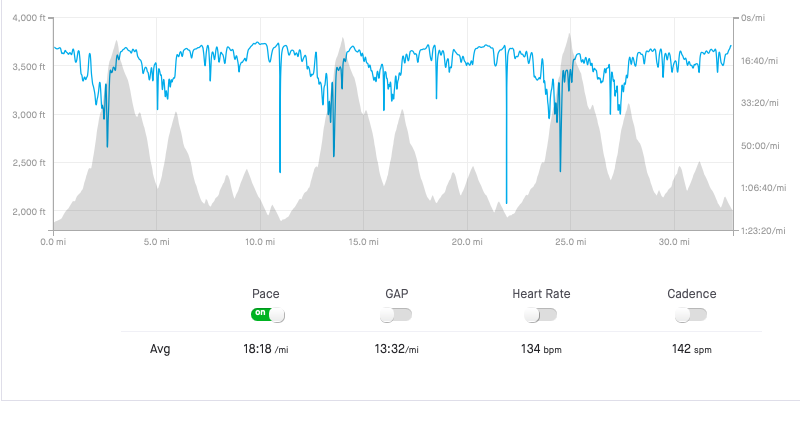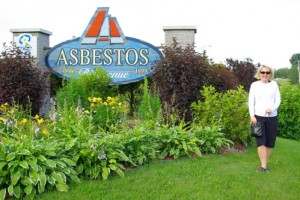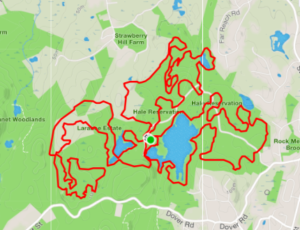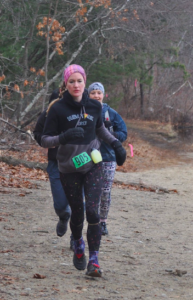Typically, ultra race reports are written within 1-2 weeks of the event and are full of fresh descriptions of the course, aid stations, etc. This particular one I’m writing over 7 months post-race, so there’s not many useful details if you’re here for reconnaissance. This is much more of a personal reflection about how I survived and even thrived during the pandemic by having the Riverlands 100 to train for and eventually finish.
The Signup
I signed up for the Riverlands 100 on August 30, 2020, after the long, horrible Covid spring and a nightmare summer. Life bottomed out in mid-August. Then, we went on a vacation: Vermont State Park camping, followed by a week in a Cape Cod shack. The thorough bleakness of that vacation cannot be overstated, yet the respite from the drudgery of my early pandemic life forced a sudden mental clarity about what I needed to do:
100 miles in Maine.
After I signed up, the concreteness of those words — 100 miles in Maine — became the foundation on which I structured my dissolving life. To run 100 miles in Maine required more than pure running. I needed my professional life to be balanced. I needed my son to thrive so it didn’t feel like abandonment every time I disappeared for a long run. I needed to quit drinking alone in my house as a way of coping with pandemic isolation. I needed to foam roll, do yoga, meditate, write in my journal, and read books. The pandemic sapped all of my intrinsic motivation to attend to these priorities; 100 miles in Maine became my extrinsic motivation.
Yes, I keep mentioning the fact that it’s in Maine. The location was every bit as a milestone as the distance. Travel to Maine was uncertain until about a month out from the race. The vaccines had arrived, the world was opening up, and being able to leave my local area to run with others gave me incredible joy.
Training
With eight months to train, my plan was simple: Every morning, run 90 minutes of Zone 2 effort on the gnarliest trails on my local conservation lands. Add weekend long runs (5-8 hours) in the last three months. About every ten days, I took 2-3 rest days in a row.
The “peak” of training was the TARC Don’t Run Boston 50K in April, perfectly timed 3 weeks before Riverlands. In any other year, finishing the DRB 50K would be a headlining achievement. But 2021 was all about 100 miles in Maine.
The Course
Here’s a brief summary of the course taken from the Ultrasignup page. (I think the description underplays the rocks, but mud wasn’t an issue. Nor were loons for that matter.)
Solo runners will do 4 laps of a beautiful 25-mile out-and-back trail at the Androscoggin Riverlands State Park in Turner, ME. The course is a little over half ATV trail that has a little of everything: river views of the Androscoggin (listen for loons!), dense forest, ups and downs, rocks and roots and hopefully some good mud. The rest is sweet single track, the best Maine offers.
https://ultrasignup.com/register.aspx?did=78584
I stayed at a chain hotel in nearby Lewiston, Maine, a town that had a surprisingly urban feel amid the vast rural landscape. There was an option to camp, but since I was crew-less I opted for the ease and comfort of a hotel. I booked for the Friday night before and the Sunday night after the race, to ensure solid sleep before attempting the 3-hour drive home. (This Sunday night hotel reservation turned out to be an excellent motivator during the race to stay on the course and finish.)
Starting Line
Race morning was cool and cloudy. As I stood on my mark at the socially-distanced starting area, some women relay runners chatted nearby. “This is the best I’m going to feel all day!” one of them said, as the others reacted with commiseration and encouragement.
In my head, I disagreed. I will feel better… the more miles I finish. That’s my zen of ultrarunning. The best I will feel… is when it is over.
Loop 1, Miles 1-25 (6 hours, 15 minutes)
My race strategy was to maintain a conservative yet consistent pace that left a small buffer for finishing before the 32-hour cutoff. I wanted to do the first 50 in 14 hours, leaving 18 hours for the last 50. This meant I spent the first loop at the back of the pack. Actually, I went faster than I would have liked, but this was the most social loop and the miles passed easily with other energized runners. However, the faster-than-comfortable pacing may have caused digestive issues that started on Loop 2…
Loop 2, Miles 25-50 (About 7 hours)
I have no distinct memories of this loop, except tripping and falling around mile 42 on the ATV trail. I can see from my heart rate data that I paced myself a little better than the first loop. When I ran with people, the light-hearted banter turned fatigued. By the end of the loop, I had major nausea that increased the more I tried to eat (this was the first and only serious impediment I had the whole race).
Loop 3, Miles 50-75 (About 9 hours)
I started Loop 3 around Saturday 11pm, still wreaked with nausea. If I had a logistical “easy out,” I probably would have quit. But my hotel room was for Sunday night, so DNF-ing now meant sleeping in my car, driving home in shame in the morning and forfeiting the hotel room.
I texted Mr. P. that I wanted to stop, and he sagely reminded me how much better everything would be at daybreak. I walked nearly all of the trail sections on this nighttime loop. Having my trekking poles was a huge boast, and I still managed 20-minute miles despite the nausea. Unfortunately, I lost a ton of time in the aid stations trying in vain to either eat and/or vomit.
When I was finishing the loop, the male leaders passed me on their way to the finish, apparently having quite a bro-mance, according to post-race interviews.
Loop 4, Miles 75-100 (About 7 and a Half Hours)
Pancakes. Pancakes saved my race. The minute I saw those flat saucers of flour — individually wrapped for sanitation — my stomach assented. My mouth watered. On my way out at Mile 75, I cleaned the start/finish aid station out of pancakes. I would have taken more if I could.
Loop 4 was the most memorable loop of the day. The pancakes quickly hit my pancreas and I moved much better on the rocky trail in the full light of the morning. I started drinking large amounts of Mountain Dew at every aid station stop. It was the purest sugar buzz I’ve ever felt.
At aid stations and with other runners, I was either completely silent and focused, or babbling with emotion. Luckily ultra aid station volunteers are pretty legendary for putting up with a lot from runners. When I shared to one volunteer how much this race meant to me, he seemed touched and suggested I share this with the Race Directors.
The Finish and the Reckoning
Nearing the finish line, I broke into a sprint to the cheers of the small crowd of 15-20 people gathered around the timing table and the aid station in the parking lot. Maybe it’s showing off to sprint at the end of a 100-miler, but I was proud of how strong I felt at that moment, a tribute to the eight months of training that had improved my entire life.
After I crossed the finish line and the polite applause subsided, I stood there awkwardly, smiling, maskless. One of the Race Directors asked me if I was going to the after-party to get my buckle, and I asked about a few details about the party, and got answers.
Before I turned away to get myself together, it seemed like a good opportunity to thank the RDs, like the aid station volunteer had earnestly advised me at mile 95. Only, I didn’t plan out my words and gave a short, jumbled statement, something like, “I just wanted to let you know how much this race had meant to me, it really got me through the pandemic, it was so great to run this race, blah blah…”
One of the RDs, masked, kind of nodded politely at the cheesy way I expressed myself, seconds after finishing a 100 mile run. Most of the other people at the finish line appeared not to be listening.
But then, a woman who was sitting with the RDs chimed in. She obviously honed in on my awkwardness and couldn’t resist. She said loudly in a super bitch voice, “Hey everyone, listen up! It’s another person talking again about how great it to be at a race again!” She smirked at me and the entire finish line went silent and stared.
There’s this ‘out of body’ feeling that I get when I am being publicly humiliated. In middle school, I had this feeling everyday for three years due to ridicule and bullying about my acne. It’s as if my mind is so acutely aware of how I’ve been insulted, it must escape my body, which then can’t speak or move. I remember multiple kids bullying me about how I reacted when I was being bullied – my jaw went slack, my eyes vacant. I’m pretty sure that’s how I looked at the finish line, as the stares and silence around me stiffened. I just stood there like a giant exhausted idiot.
Every part of me wanted to drive away from the race, but I couldn’t leave without the damned buckle. I forced myself to nap in my car, to wake up 40 minutes later, to drive to the after-party location, to park, to walk 5 painful minutes to the pavilion, and to wait to have my buckle presented to me by the RDs. My spirits were high — I finished, and I was happy to see some familiar runners get their buckles. But, having the RD hand me the buckle stirred a vivid memory of what happened at the finish line — and my powerless, humiliated response.
As soon as the buckle presentation ended, I left the party and started the long walk back to my car so I could go eat a burger, shower, and sleep deeply in my hotel room. My 100 miles in Maine was complete.
The Video
There’s a cool video on YouTube that someone took of the race. I saw this person on the course filming and thought they were taking pictures, which is one of several reasons why I didn’t take any photos. I did make it into the video at minute 6:27.
